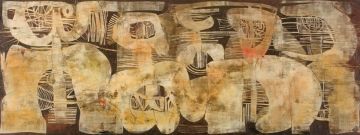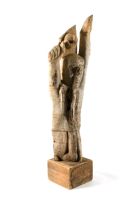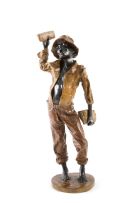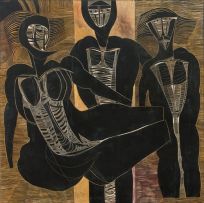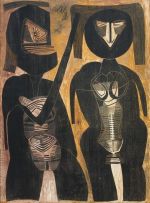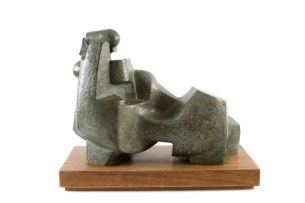Important British, Continental and South African Paintings
Live Auction, 24 May 2010
Session Two
Incl. Buyer's Premium & VAT
About this Item
signed and dated 65
Notes
Amadlozi, meaning 'spirit of the ancestors', was the name conceived by Sydney Kumalo for a group of artists that included Edoardo Villa, Cecil Skotnes, Giuseppe Cattaneo and Kumalo.[i] Ezrom Legae was closely associated with the artists. Goldsmith and art dealer, Egon Guenther, curated their first exhibition which opened in his Johannesburg gallery in October 1963. Vittorino Meneghelli, through his Italian contacts, arranged for the exhibition to tour Rome, Florence, Milan and Venice in 1963 and 64.
Guenther, who believed that a significant work of art should reflect its time and environment, was instrumental in encouraging these artists to draw on African inspiration for their work. Exposure to his significant collection of traditional African art at a time when these could not be seen in South Africa's public institutions or market places, located the group at the forefront of serious discussions and analyses of African art in southern Africa.[ii] Although the artists never exhibited together again as the Amadlozi Group, their impact on South African art was to be profound.
The artists would look to the African environment, its dramatic forms and cultural milieu which, together with their understanding of European modernism, they forged into new formal languages that were innovative and distinctly African. In 1964 Villa modelled in clay and had cast in bronze a series of monumental heads that suggest the faceted planes of African masks and of Analytical Cubist sculpture. Reclining Nude, dated 1968, and Standing Figure, dated 1970, reveal how Villa was shifting towards abstraction without abandoning the human form so central to his work.
Drawing on South Africa's abundant resources of iron-ore and steel, Villa developed unique forms of expression using these local materials to reflect an increasingly industrialised and mechanised age. Heraldic Figure and the two bas-relief sculptures with their sharp thorn-like forms also reflect the local flora. In addition, their verticality, symmetry and strong presence evoke traditional African sculpture.
Like Villa, Giuseppe Cattaneo was also Italian-born. Inspired by his experience of mining, he experimented with metallurgical materials to express his African-inspired conceptions. His African Shield, created with epoxy-bound pigments on steel, like Thorned Condition on this auction, won him the Second Annual Artists of Fame and Promise award in 1960.
Cecil Skotnes was appointed Cultural Recreation Officer at the Polly Street Centre in 1952 where Sydney Kumalo began attending classes at that time before being appointed Art Organiser in 1958[iii]. Legae joined in the activities when the Polly Street Centre relocated to the Jubilee Centre in the early 1960s and was later appointed to a post there. Skotnes introduced Kumalo and Legae to Guenther, whose astute criticism and market promotion were to prove invaluable.
Skotnes also arranged for Kumalo to work with Villa twice a week from 1958 to 1960, and later Legae also assisted Villa, initiating an association that was to affect the work of all three sculptors. Skotnes discussed with Kumalo the Cubist approach to the simplification of three-dimensional form[iv] that is evident in the latter's planar treatment of the human form in Standing Female Figure. Legae's Torso shares many of the characteristics of African art and European modernism with which his fellow artists were grappling.
Guenther also acquainted Skotnes with contemporary German graphic artists, who were to have a seminal influence on his early woodcuts. Seeing the potential of developing his original wood blocks into the incised paintings on wood, he evolved this unique art form into his signature work. The magnificent African Figures, an early panel produced in 1965 on a monumental scale, uses a dark ground with raised figures embellished with marble dust and ochre oxides. By contrast, in Three Figures and Two Figures, the incised backgrounds are painted with oxides with the figures finished in flat black to create dramatic effects. The unusual African Head, with its dynamic pattern of raised black lines dividing areas of luminous colour, captures the bejewelled quality of stained glass windows.
The exchange of ideas and practices at the Polly Street Centre and through the Amadlozi Group were undoubtedly the catalysts in developing the African-inflected style, content and technique of this extraordinary group of pioneering artists. Rarely does an auction provide such a broad selection of works by so important a group, making it possible for auction goers to appreciate individual works and trace networks of influence and inspiration between artists and collectors.
[i] Information provided by Egon Guenther interviewed by Emma Bedford, 26 March 2010. Cecil Sash was the fifth member of the Amadlozi Group.
[ii] See Karel Nel, 'Edoardo Villa: Creating an African Presence' in Karel Nel, Elizabeth Burroughs and Amalie von Maltitz (eds), Villa at 90, Jonathan Ball Publishers, Johannesburg and Cape Town, 2005, pp 121-147.
[iii] Information obtained from Elizabeth Rankin, 'Teaching and Learning: Skotnes at Polly Street' in Frieda Harmsen (ed), Cecil Skotnes, South African National Gallery, 1996.
[iv] Ibid.

